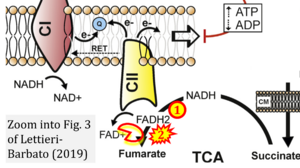Lettieri-Barbato 2019 Mol Metab
| Lettieri-Barbato D (2019) Redox control of non-shivering thermogenesis. Mol Metab 25:11-9. https://doi.org/10.1016/j.molmet.2019.04.002 |
Lettieri-Barbato D (2019) Mol Metab
Abstract: Background: Thermogenic adipocytes reorganize their metabolism during cold exposure. Metabolic reprogramming requires readily available bioenergetics substrates, such as glucose and fatty acids, to increase mitochondrial respiration and produce heat via the uncoupling protein 1 (UCP1). This condition generates a finely-tuned production of mitochondrial reactive oxygen species (ROS) that support non-shivering thermogenesis.
Scope of review: Herein, the findings underlining the mechanisms that regulate ROS production and control of the adaptive responses tuning thermogenesis in adipocytes are described. Furthermore, this review describes the metabolic responses to substrate availability and the consequence of mitochondrial failure to switch fuel oxidation in response to changes in nutrient availability. A framework to control mitochondrial ROS threshold to maximize non-shivering thermogenesis in adipocytes is provided.
Major conclusions: Thermogenesis synchronizes fuel oxidation with an acute and transient increase of mitochondrial ROS that promotes the activation of redox-sensitive thermogenic signaling cascade and UCP1. However, an overload of substrate flux to mitochondria causes a massive and damaging mitochondrial ROS production that affects mitochondrial flexibility. Finding novel thermogenic redox targets and manipulating ROS concentration in adipocytes appears to be a promising avenue of research for improving thermogenesis and counteracting metabolic diseases.
• Bioblast editor: Gnaiger E
Correction: FADH2 and Complex II
- FADH2 is shown as the substrate feeding electrons into Complex II (CII). This is wrong and requires correction - for details see Gnaiger (2024).
- Gnaiger E (2024) Complex II ambiguities ― FADH2 in the electron transfer system. J Biol Chem 300:105470. https://doi.org/10.1016/j.jbc.2023.105470 - »Bioblast link«
Labels:
Enzyme: Complex II;succinate dehydrogenase


